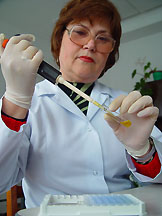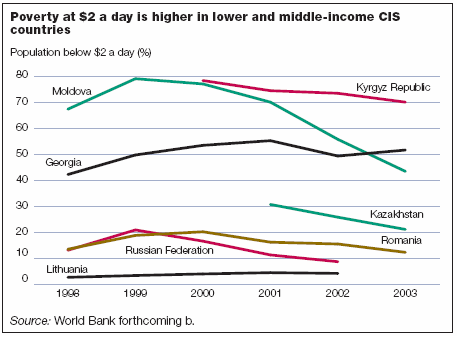Washington DC, September 9, 2005 - Recent progress in Europe and Central Asia has led some people to suggest the war on poverty has been won. The challenges however remain daunting. More than half of the countries in the region are unlikely to meet at least one of the Millennium Development Goals (see box below). Europe and Central Asia is experiencing one of the fastest growing HIV/AIDS epidemics worldwide, and tuberculosis is on a steady rise.
Poor water quality in many countries poses a significant health threat, putting the goal of ensuring environmental sustainability out of reach.
In this Year of Development, measuring progress on MDGs is a growth industry. This is true not just in Africa, where the challenges are the most daunting, but also in the ECA region, where some countries are doing relatively well, while others have a long way to go. A new report which looks at progress and prospects in Europe and Central Asia finds that while ECA's progress toward attaining the MDGs is generally promising, it is also uneven. This is true both in poor countries such as Tajikistan and Moldova as well as in better off countries such as Russia where, for instance, the HIV/AIDS sub-target will definitely not be met. Health and Child Mortality Remain Big Challenges  The health MDGs present the biggest challenge to the region. Denial, stigma, and the institutional challenges of providing services to marginalized and vulnerable groups remain serious obstacles to progress in stemming the numbers of people living with—and dying—of AIDS. The health MDGs present the biggest challenge to the region. Denial, stigma, and the institutional challenges of providing services to marginalized and vulnerable groups remain serious obstacles to progress in stemming the numbers of people living with—and dying—of AIDS.
Child mortality rates of 58 per thousand births across the region is another major challenge, especially as progress may be blocked because many people shun hospitals due to concerns about quality and costs.
Education and Gender Equality are Bright Spots
 On the other hand, trends in education and gender equality, a legacy of the Soviet era, have been very positive. Indeed, the report finds the best outcomes have been on the MDG for gender equality in schools, because of the region’s tradition of equal access to education. On the other hand, trends in education and gender equality, a legacy of the Soviet era, have been very positive. Indeed, the report finds the best outcomes have been on the MDG for gender equality in schools, because of the region’s tradition of equal access to education.
While the MDGs have become widely accepted as a framework for measuring development progress globally, the ECA region has several special characteristics which must be kept in mind when assessing the prospects of MDG achievement.
The 1990 baseline used in assessing progress on the MDGs is unsuitable in many instances because it marked the beginning of what was a wrenching—and pauperizing—transition, one accompanied by conflict in many places. In addition, the cold climate in many parts of the region means that spending on food, heat, and winter clothing is higher than in other regions, making a poverty line of $2.15, rather than $1 a day, more appropriate.

Overall, the ECA region has been moving in the right direction, with 40 million people lifted out of poverty between 1999 and 2003. But, across the region, $2 a day poverty is still significant. Even better-off countries such as Kazakhstan and Russia have poverty headcounts of 10 to 20 percent by this measure, and in Georgia more than half the population remains poor. While more than half the ECA countries have already achieved or are likely to achieve the poverty MDG, none of the low-income CIS countries, except Azerbaijan, are likely to halve poverty by 2015.
“These data tell us that meeting the goals in the next decade will require major efforts in countries like the Kyrgyz Republic, Georgia and Tajikistan, as well as a continuation of the progress seen in Armenia, Moldova, and Uzbekistan,” says Shigeo Katsu, ECA Regional Vice President. Pockets of poverty in low and middle income countries, including in Central and South Eastern Europe where Roma people live, also need special attention, he noted.
The Millennium Development Goals (MDGs)
| - Eradicate extreme poverty and hunger
- Achieve universal primary education
- Promote gender equality and empower women
- Reduce child mortality
- Improve maternal health
- Combat HIV/AIDS, malaria, and other diseases
- Ensure environmental sustainability
- Develop a global partnership for development
For more information, visit the World Bank's MDG website.
|
Back to Top |

